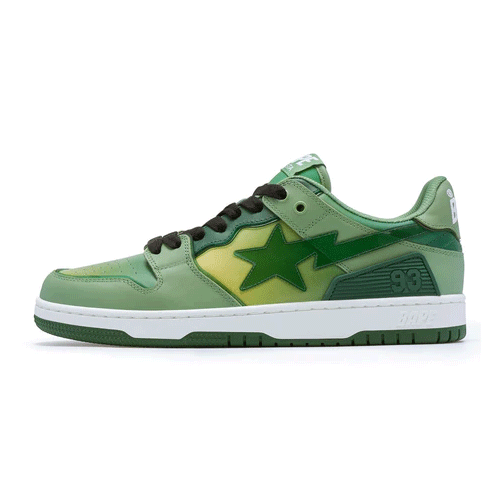In the ever-evolving world of sneakers, few silhouettes have managed to remain as instantly recognizable and culturally influential as the Bapesta. Born from the intersection of Japanese street fashion and global hip-hop culture, the Bapesta is more than just a shoe—it’s a statement. With its flashy designs, celebrity endorsements, and legacy of bold innovation, the Bapesta has carved out a space in sneaker history that’s both unique and enduring.
This article explores the origins of the Bapesta, its cultural impact, design evolution, and why it continues to be one of the most sought-after sneakers in streetwear today.
The Origins of Bapesta: A Bathing Ape’s Bold Move
The Bapesta was first released in the early 2000s by A Bathing Ape (BAPE), a Japanese streetwear brand founded in 1993 by Nigo. Known for its loud camo patterns, shark hoodies, and commitment to exclusivity, BAPE was already a powerhouse in Japanese fashion. But with the Bapesta, the brand took its first major step into the world of footwear—and it did so with fearless audacity.
The sneaker drew immediate comparisons to Nike’s Air Force 1 due to its similar silhouette. However, the Bapesta made its mark through loud colorways, patent leather finishes, and the instantly iconic star logo replacing the Swoosh. While critics initially labeled it a “knockoff,” Bapesta’s unique flair, limited production, and cult following quickly helped it earn legitimacy in the sneaker world.
The Rise of the Bapesta in Hip-Hop Culture
Much of the Bapesta’s global appeal can be traced back to its deep connection with hip-hop. In the early 2000s, American rap artists began embracing Japanese fashion and streetwear, and BAPE quickly caught their attention. When Pharrell Williams and Kanye West were seen rocking Bapestas, the sneaker’s popularity exploded in the West.
Pharrell’s Billionaire Boys Club and Kanye’s collaborations with Nigo helped cement a cross-cultural exchange between Japanese streetwear and American hip-hop. Bapesta became the go-to sneaker for artists who wanted to stand out—not just because of its exclusivity, but because it was loud, colorful, and unapologetically flashy. In an era when self-expression was everything, the Bapesta became a symbol of individuality and rebellion.
Design Evolution: Loud, Limited, and Legendary
One of the reasons the Bapesta remains a favorite among collectors and fashion-forward youth is its relentless commitment to bold design. Unlike traditional sneaker brands that may release understated colorways for mass appeal, BAPE embraced maximalism. Patent leather in neon green, candy red, metallic blue, or camouflage made each pair look like wearable pop art.
Each release often came in limited quantities, which added to the hype and resale value. From collaborations with Marvel Comics, DC, SpongeBob SquarePants, and even Kanye West’s College Dropout bear, the Bapesta wasn’t just a sneaker—it was a canvas for pop culture.
In recent years, BAPE has updated the silhouette slightly, improving quality, materials, and comfort, while keeping the original spirit alive. This evolution has helped the brand stay relevant with younger sneakerheads while preserving its heritage appeal among longtime collectors.
Bapesta vs. Air Force 1: Copy or Cultural Remix?
The similarities between the Nike Air Force 1 and the Bapesta have long been debated in the sneaker community. While the initial design of the Bapesta undoubtedly borrows heavily from the Air Force 1’s shape and paneling, it’s crucial to understand the context of streetwear during that time.
In the early 2000s, remixing and reinterpreting fashion staples was not uncommon in Japanese streetwear. Nigo was transparent about his admiration for American hip-hop culture and sneakers, and the Bapesta was his homage to the Air Force 1, filtered through a distinctly Japanese lens. By replacing the Swoosh with the “STA” lightning bolt, using unconventional colors, and infusing it with BAPE branding, he created something that was both familiar and entirely new.
In many ways, the Bapesta isn’t a copy—it’s a reinterpretation, a cross-cultural dialogue between East and West that gave birth to a streetwear icon.
The Resurgence of Bapesta in Modern Fashion
With the cyclical nature of fashion trends, the Bapesta has seen a strong resurgence in recent years. As Y2K aesthetics, retro streetwear, and nostalgia-driven styles come back into vogue, the demand for OG and re-released Bapestas has surged.
Collaborations continue to play a major role in Bapesta’s longevity. Recent drops have included partnerships with Coach, Reebok, and a host of streetwear designers who bring new perspectives to the iconic silhouette. Limited drops, raffles, and pop-up exclusives ensure that Bapesta continues to be a grail for collectors.
Additionally, social media has given Bapesta a new platform. Instagram and TikTok are filled with unboxings, fit pics, and Bapesta styling guides, helping introduce the sneaker to a younger generation who may have missed its early 2000s heyday.
Why Sneakerheads Still Love the Bapesta
There’s no shortage of sneaker options in the market today, but the Bapesta continues to stand out for a few key reasons. First, its history is rich with cultural moments—from rap lyrics to rare collabs. Owning a pair of Bapestas is like owning a piece of streetwear history.
Second, the Bapesta speaks to those who want to break the mold. Its loud colors and glossy finish aren’t for everyone—and that’s the point. It’s a sneaker for the bold, the expressive, and the fashion-literate.
Lastly, BAPE’s continued control over supply and exclusivity has preserved the mystique of the Bapesta. Unlike many mass-produced sneakers, Bapesta releases still feel special. That scarcity, combined with its vibrant aesthetic and cultural relevance, keeps demand high.
How to Style Bapestas Today
Bapestas are a versatile yet bold statement sneaker that can be styled in numerous ways, depending on your fashion goals. Pair them with baggy denim, oversized hoodies, and vintage tees for a throwback Y2K look. For something more modern, mix them with neutral streetwear pieces and let the sneaker be the focal point.
Bapestas work especially well with Japanese brands like Neighborhood, WTAPS, and Human Made, or can be paired with Western streetwear staples like Supreme, Stüssy, and Off-White. The key is to balance the loudness of the shoe with complementary, cohesive fits.
Final Thoughts: A Legacy That Keeps Evolving
The Bapesta is more than a sneaker—it’s a cultural artifact. Born from the vision of a Japanese designer deeply inspired by American hip-hop and sneaker culture, the Bapesta became a bridge between two worlds. It challenged ideas of originality, brought high fashion to streetwear, and helped define a generation of fashion rebels.
Today, it remains as relevant as ever, embraced by both old-school collectors and Gen Z trendsetters. As fashion continues to cycle through nostalgia, innovation, and cultural fusion, the Bapesta stands as a symbol of fearless creativity in a world of conformity.

